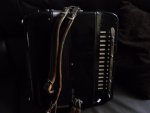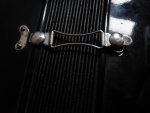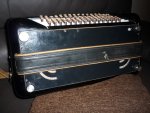AimlessWanderer pid=69302 dateline=1578928776 said:
The noisy typewriter is here

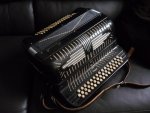
It does appear to have two voices via the large slide bar underneath

However, it also needs some mechanical attention (which wasnt unexpected at the price I paid). Some of the bass keys are sunken, and if I lift it at one end, it slowly opens and reeds are sounding, so I have some sticky keys to fix.

Aside from that, the only other niggle that Ive noticed, is the stud for the upper bellows strap seems slightly displaced, and I cant close that strap, even though the bellows close fully (the stud for clipping the strap open is in the right place).
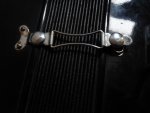
Apologies for the dark images. Rather overcast here today, so natural light was somewhat lacking.
Hi,
You have some issues there with your Belgian bass system, and the sound you are hearing when lifting it up will probably be because one or more of the bass buttons are partially stuck down.
Where do we begin? Regardless of what system you have on the treble side, you are probably now a member of the smallest accordion club in the UK. Belgian bass in the UK is very rare indeed, and that one needs fixing.
Youll need to separate the entire bass side of your accordion from the bellows by removing the bellows pins on the front and rear of the bass side casing. As with many things accordion, a special tool makes that easier, but you should be able to get the (usually 6) pins out by carefully pulling them with smallish pliers. Try and remember what pin goes where for reassembly, as they say the same pin should go back in the same hole for the sake of airtightness.
You can then rest the bass side on a flat surface for the difficult bit. All of your 96 bass button heads need to be unscrewed so that you can remove the small screws on bass side keyboard plate. When you lift the keyboard plate off take a photo of the entire bass mechanism, in case you run into difficulties with what goes where on reassembly.
Seems your bass side has sustained a bit of a bashing and some of the control levers have either been displaced or knocked out of alignment. Ideally, you would want to remove the bass control system in its entirety, but that may not be possible on your instrument.
You then need to fix all the control levers to the affected buttons so that the buttons are all roughly at the same height. The control levers run from the buttons to the mechanism used to activate the pallets, and each one will be more or less unique in its configuration. Without expensive special tools youll not get them spot on, but if you can get the sunken buttons back to roughly the same height as their original positions then youll do well. It may be necessary to bend the wonky rods back to their original configuration, taking care not to overbend or break the rods. Bending or otherwise altering them has to be done with extreme care, as if you get it wrong the affected button(s) will simply drop back down again the next time the box gats a slight knock.
I have done such a job on two separate occasions on a Cavagnolo 120 bass accordion and it isnt for the faint of heart. I cut a cardboard strip for each of the six rows of buttons and pushed each control lever through it to keep them in the correct order (no mobile phones in those days).
Until youve managed to resolve the bass side issue there will be no point in trying to attend to any of the reeds. Belgian basses usually have 3 rows of chords and 3 rows of single bass notes. Looking at the photos, it seems that all of your affected buttons will only control a single note each.
If you run into difficulties, or decide repair is a bit of a tall order, it may be a good idea to contact a repairer, if only for advice. I doubt there will be any spare parts available for Belgian bass accordions in the UK, but you never know.
If your luck was really in you may be able to source an entire bass side to match the treble side you have, and hopefully it will have a standard Stradella 96 bass.
If you manage to fix the bass side, learning Belgian bass in the UK could be difficult. If you Google Hamelrijk in Brussels, it is an accordion shop dealing in all sorts of bass systems, and they may be able to advise you where you could obtain a method book that covers the Belgian bass system. It is usually described as an upside down Stradella system, which is an approximation. The sharps are at the bottom of the keyboard and the flats are at the top.
It is a bit of a project, but not insurmountable. Any broken parts can occasionally be replaced by home made substitutes if you are able to make them yourself. Bellows straps of the type you have are easy enough to source.
[font=Tahoma,Verdana,Arial,Sans-Serif]There are a few Belgian members on the forum, and several others with detailed technical knowledge with regard to the workings of your noisy typewriter. [/font]


